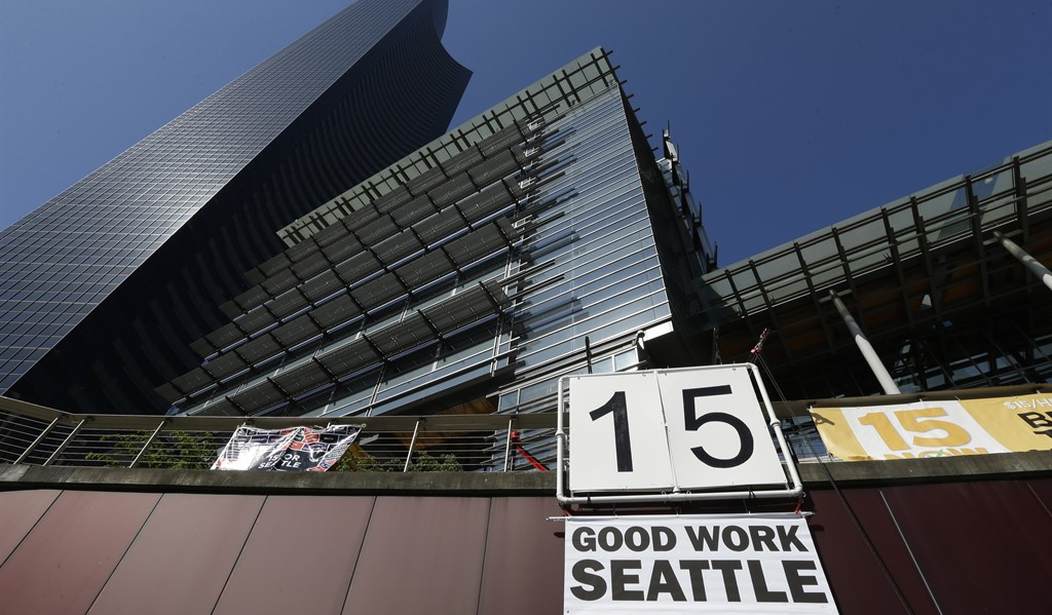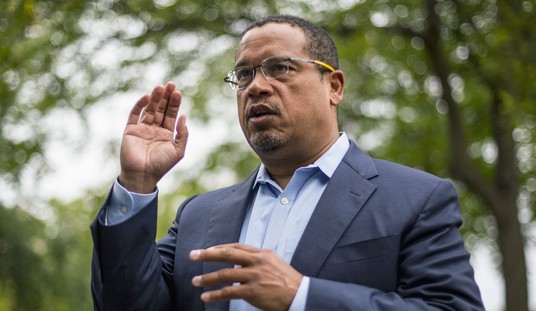Oh, let’s not always see the same hands. Seattle led the way for imposing dramatic increases in the minimum wage to $15 per hour over a span of a few years arguing that it would lift the fortunes of low-wage earners. Several cities and states have followed suit, including Los Angeles, as its main daily notes today while reporting on a study that calls that assumption into serious question. It turns out that low-wage earners might be getting the shaft rather than an elevator:
It’s one of the core questions in the debate over minimum wage: Does hiking the pay floor lead businesses to cut hours and jobs?
A much-anticipated study released Monday by a team of researchers at the University of Washington is likely to intensify that controversy — just as Los Angeles heads toward its own minimum-wage increase for large businesses, from $10.50 an hour to $12 an hour on July 1.
The new study has found that jobs and work hours fell for Seattle’s lowest paid employees after the city raised the minimum wage to $13 last year.
The analysis shows that jobs and hours for those workers declined faster in Seattle than in surrounding control areas, where the minimum wage did not increase.
For those well versed in the laws of supply and demand, especially in the labor market, this isn’t exactly a shock. Opponents of the minimum-wage hikes argued all along that the imposition of artificial extra costs to labor would have significant and unplanned consequences, among them a consolidation of jobs and hours offered, more automation to replace low-skill labor, and a shift away from inexperienced applicants in favor of more skilled workers. According to the study, that’s precisely what happened in Seattle:
Our preferred estimates suggest that the Seattle Minimum Wage Ordinance caused hours worked by low-skilled workers (i.e., those earning under $19 per hour) to fall by 9.4% during the three quarters when the minimum wage was $13 per hour, resulting in a loss of 3.5 million hours worked per calendar quarter. Alternative estimates show the number of low-wage jobs declined by 6.8%, which represents a loss of more than 5,000 jobs. These estimates are robust to cutoffs other than $19.45. A 3.1% increase in wages in jobs that paid less than $19 coupled with a 9.4% loss in hours yields a labor demand elasticity of roughly -3.0, and this large elasticity estimate is robust to other cutoffs.
These results suggest a fundamental rethinking of the nature of low-wage work. Prior elasticity estimates in the range from zero to -0.2 suggest there are few suitable substitutes for low-wage employees, that firms faced with labor cost increases have little option but to raise their wage bill. Seattle data show – even in simple first differences – that payroll expenses on workers earning under $19 per hour either rose minimally or fell as the minimum wage increased from $9.47 to $13 in just over nine months. An elasticity of -3 suggests that low-wage labor is a more substitutable, expendable factor of production. The work of least-paid workers might be performed more efficiently by more skilled and experienced workers commanding a substantially higher wage. This work could, in some circumstances, be automated. In other circumstances, employers may conclude that the work of least-paid workers need not be done at all.
Importantly, the lost income associated with the hours reductions exceeds the gain associated with the net wage increase of 3.1%. Using data in Table 3, we compute that the average low-wage employee was paid $1,897 per month. The reduction in hours would cost the average employee $179 per month, while the wage increase would recoup only $54 of this loss, leaving a net loss of $125 per month (6.6%), which is sizable for a low-wage worker.
It’s not just the scope of the losses, but the losses themselves which are remarkable for the public debate. Advocates of minimum-wage hikes routinely decry the plight of low-wage earners (and not for no good reason), but the impact of this policy doesn’t improve their lives; it actively makes matters worse. As the opportunities for unskilled workers dry up, they have fewer opportunities to earn any living, while the labor market shifts to better-skilled workers who already had an advantage in the marketplace. In the meantime, the added labor costs also will force the cost of living upward, making the decline for unskilled workers even more dramatic.
Needless to say, advocates for minimum-wage hikes will not find this study to their taste, and many are pointing out that it has yet to pass through peer review. It also uses a different methodology than other studies on this policy have used in the past, but that was by design, the Washington Post notes. It’s the first time a study has focused specifically on low-wage workers rather than look at employment in general:
Their studies examined the overall numbers of workers or their annual incomes, but lacked precise information on how much workers were being paid by the hour. As a result, past research might be less reliable because the results might reflect many workers who are not paid low wages, said Jacob Vigdor, an economist at the University of Washington and one of the authors of the new study.
Their research, using detailed records from the state of Washington, addresses that problem.
“That’s really a step beyond what essentially any past studies of the minimum wage have been able to use,” said Jeffrey Clemens, an economist at the University of California, San Diego who was not involved in the research.
And while the study has not undergone a formal peer review yet, it has been reviewed by outside economists — who find it “very credible” indeed:
“This strikes me as a study that is likely to influence people,” said David Autor, an economist at the Massachusetts Institute of Technology who was not involved in the research. He called the work “very credible” and “sufficiently compelling in its design and statistical power that it can change minds.”
Artificially increasing the cost of any commodity will reduce the demand for it, especially with labor in a relatively slack market. It will also incentivize the pursuit of alternatives to labor, which we have begun to see in the casual-dining market already with the advent of automated ordering. The better way to raise wages is to create an economy with strong job creation that lowers the costs of employing people, but unfortunately we have pursued policies for the past eight years that took us in the exact opposite direction — especially with ObamaCare and the employer mandate. Furthermore, raising costs for employers means that consumers pay more for goods and services, an issue which this study doesn’t address at all but which produces even more deleterious effects that impact low-wage earners disproportionally.
Will this study force policymakers to think twice about hiking the minimum wage? As Autor says, “If I were a Seattle lawmaker, I would be thinking hard about the $15 an hour phase-in.” Don’t bet on rational thinking and basic economics to take precedence, though.








Join the conversation as a VIP Member